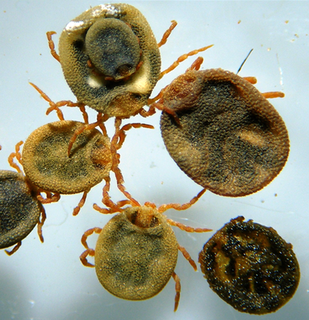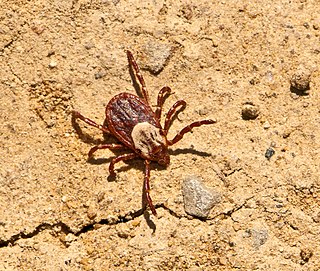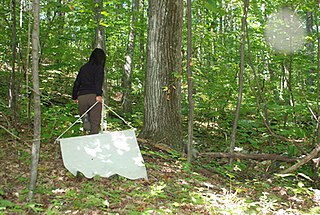
Acarology is the study of mites and ticks, the animals in the order Acarina. It is a subfield of arachnology, a subdiscipline of the field of zoology. A zoologist specializing in acarology is called an acarologist. Acarologists may also be parasitologists because many members of Acarina are parasitic. Many acarologists are studying around the world both professionally and as amateurs. The discipline is a developing science and long-awaited research has been provided for it in more recent history.

Nuttalliella namaqua is a tick found in southern Africa from Tanzania to Namibia and South Africa, which is placed in its own family, Nuttalliellidae. It can be distinguished from ixodid ticks and argasid ticks by a combination of characteristics including the position of the stigmata, lack of setae, strongly corrugated integument, and form of the fenestrated plates. It is the most basal lineage of ticks.

Ixodes is a genus of hard-bodied ticks. It includes important disease vectors of animals and humans, and some species inject toxins that can cause paralysis. Some ticks in this genus may transmit the pathogenic bacterium Borrelia burgdorferi responsible for causing Lyme disease. Additional organisms that may be transmitted by Ixodes are parasites from the genus Babesia, which cause babesiosis, and bacteria from the related genus Anaplasma, which cause anaplasmosis.

Amblyomma is a genus of hard ticks. Some are disease vectors, for example the Rocky Mountain spotted fever in Brazil or ehrlichiosis in the United States.

Dermacentor is a genus of ticks in the family Ixodidae, the hard ticks. The genus has a cosmopolitan distribution, with native species on all continents except Australia. Most occur in the Nearctic realm.

Rhipicephalus is a genus of ticks in the family Ixodidae, the hard ticks, consisting of about 74 or 75 species. Most are native to tropical Africa.

Haemaphysalis is a genus of ticks, containing these species:

Amblyomma maculatum is a species of tick in the genus Amblyomma. Immatures usually infest small mammals and birds that dwell on the ground; cotton rats may be particularly favored hosts. Some recorded hosts include:

Tick dragging is a method for collecting ticks used by parasitologists and other researchers studying tick populations in the wild.
Ixodes hoogstraali is a species of tick endemic to the higher mountains of southwestern Arabia. The type specimens were collected at 7,400 feet (2,300 m) elevation near Ma'bar, Yemen, on king jirds, trapped beside a well in dry fields on a rocky plateau. The species was named in honor of Harry Hoogstraal, who provided the type specimens; the species is closely related to Ixodes ugandanus Neumann, 1906.
Gertrud Theiler was a South African parasitologist and teacher most noted for her work with nematodes and ticks.
Jane Brotherton Walker was a leading 20th century expert in the field of tick taxonomy, particularly in Africa.
Argas africolumbae , ' is a small soft-bodied tick that is found primarily on chickens and birds including the pale crag martin.
Makram Nasri Kaiser (1930–1996) was a medical and veterinary acarologist who was the world's leading authority on ticks of the genus Hyalomma.

Elizabeth Nesta "Pat" Marks was an Australian entomologist who described 38 new mosquito species, as well as new species of fruit flies, bugs, cockroaches and ticks. She had a PhD in insect physiology from the University of Cambridge and was a member of the Royal Entomological Society of London.
Haemaphysalis hystricis, the East Asian mountain haemaphysalid, is a hard-bodied tick of the genus Haemaphysalis. It is found in India, Sri Lanka, Vietnam, Myanmar, China, Japan, India, Indonesia, Laos, Taiwan and Thailand. It is an obligate ectoparasite of mammals. It is a potential vector of Kyasanur Forest disease virus, Coxiella sp., Ehrlichia sp., and Rickettsia japonica. In 2007, an unknown trypanosoma species known as Trypanosoma KG1 isolate was isolated from naturally infected H. hystricis ticks.

The zebra tick or yellow back tick is a species of hard tick. It is common in the Horn of Africa, with a habitat of the Rift Valley and eastward. It feeds upon a wide variety of species, including livestock, wild mammals, and humans, and can be a vector for various pathogens. The adult male has a distinctive black and ivory ornamentation on its scutum.
Maria Vladimirovna Pospelova-Shtrom was a 20th century parasitologist best known for her work delineating the biology and public health importance of ticks in western Asia and eastern Europe, contributing to the reduction of the incidence of tick-borne diseases, especially tick-borne relapsing fever.
Haemaphysalis pospelovashtromae, Pospelova-Shtrom’s USSR mountain haemaphysalid, is an ixodid tick native to Kyrgyzstan, Turkmenistan, Tajikistan, and the Republic of Georgia that parasitizes cattle and goats. The species epithet honors parasitologist Dr. Maria V. Pospelova-Shtrom.
Amblyomma albopictum is a species of tropical hard ticks. It is typically found parasitizing Cyclura nubila, Chilabothrus angulifer, Cubophis cantherigerus, Leiocephalus carinatus, and less commonly the Paraguaian hairy dwarf porcupine. The species has been found in Costa Rica, Cuba, Haiti, Honduras and the Dominican Republic, and has also been reported but not confirmed in Brazil. The tick was described by Louis Georges Neumann in 1899.












